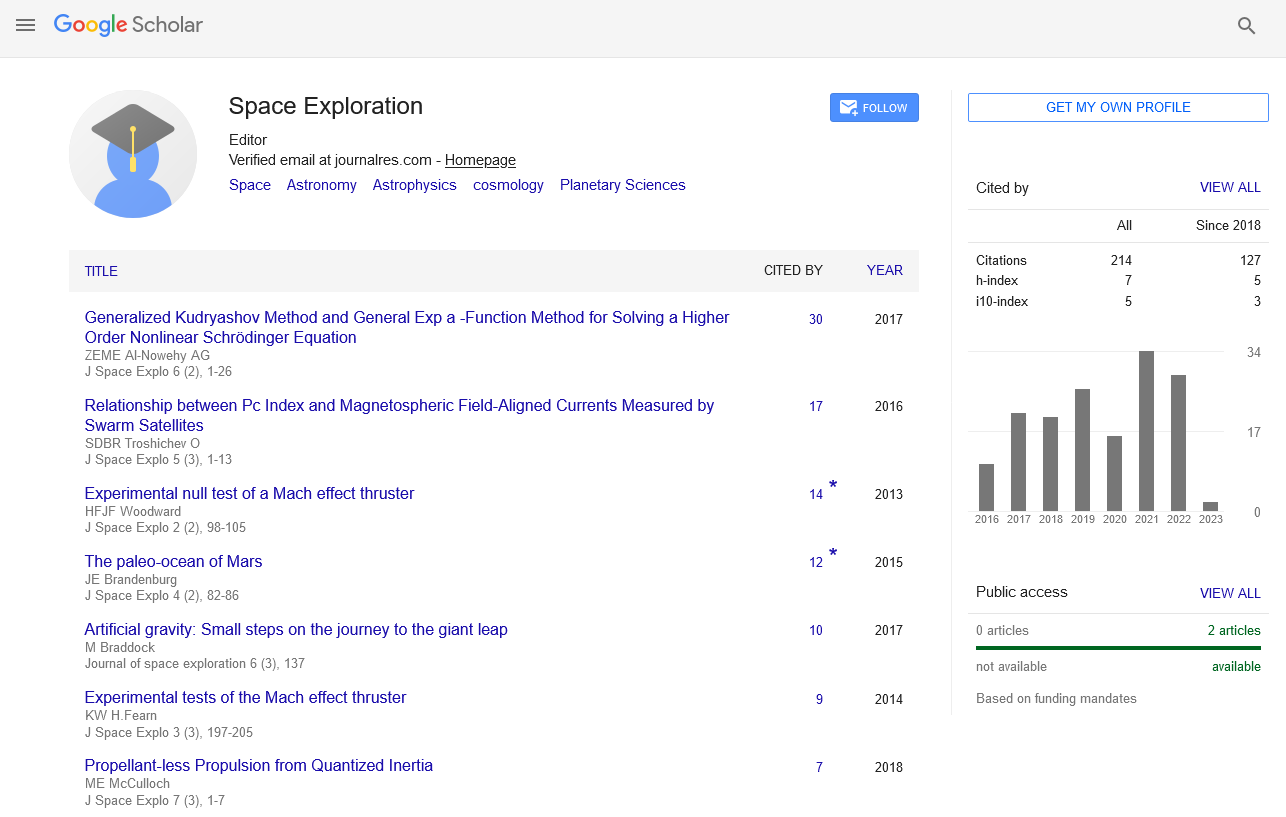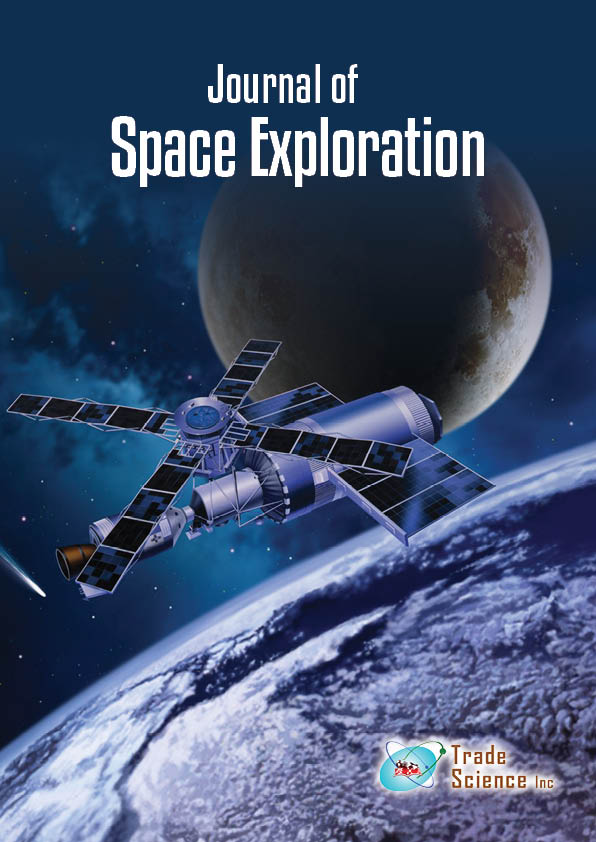Perspective
, Volume: 14( 2)Illuminating the Cosmic Distance Scale: Gamma-Ray Bursts as Standard Candles
- *Correspondence:
- Jack Wilson*
Department of Space Exploration, Technical University of Munich, Berlin, Germany
E-mail: jackwilson89@gmail.com
Received: March-20-2024, Manuscript No. TSSE-24-130148; Editor assigned: March-25-2024, Pre-QC No. TSSE-24-130148 (PQ); Reviewed: April-09-2024, QC No TSSE-24-130148; Revised: March-03-2025, Manuscript No. TSSE-24-130148 (R); Published: March-10-2025, DOI.10.37532/2320-6756.2025.14(2).386
Citation: Wilson.J. Illuminating the Cosmic Distance Scale: Gamma-Ray Bursts as Standard Candles. J Space Explor.2025;14(2).386
Abstract
Gamma-Ray Bursts (GRBs), among the most energetic events in the universe, have emerged as invaluable tools for probing the cosmos across vast distances. With their remarkable luminosities and well-defined properties, GRBs serve as "standard candles" for measuring cosmic distances and unraveling the intricacies of the universe's expansion. In this article, we delve into the fascinating world of GRBs, exploring their origins, characteristics and the methods employed to utilize them as standard candles. By harnessing the power of these cosmic beacons, astronomers gain unprecedented insights into the structure, evolution and fate of the universe.
Keywords
Cosmology; Gamma-Ray Bursts (GRBs); Hubble constantics; Cosmic expansion; Cosmic distance ladder
Introduction
Gamma-Ray Bursts (GRBs) represent some of the most luminous and energetic phenomena observed in the universe. These fleeting bursts of gamma-ray radiation have fascinated astronomers since their discovery and have since been recognized as potent tools for probing the cosmos across vast distances. By harnessing the properties of GRBs as standard candles, astronomers have unlocked new avenues for measuring cosmic distances and understanding the structure and evolution of the universe. Understanding the vast distances that separate objects in the universe is one of the fundamental challenges in astrophysics. The cosmic distance scale, a hierarchical series of methods used to measure these immense expanses, is crucial for mapping the universe's structure and determining its expansion rate. Traditionally, astronomers have relied on various "standard candles," such as Cepheid variables and Type Ia supernovae, which are objects with known intrinsic brightness. By comparing their apparent brightness to their known luminosity, distances can be calculated. This introduction sets the stage for exploring the role of GRBs as standard candles, examining their potential to revolutionize our understanding of the cosmic distance scale and offering a new window into the distant cosmos.
Description
Gamma-ray bursts: Cosmic fireworks
Gamma-ray bursts are brief, intense flashes of gamma-ray radiation originating from distant regions of the universe. They come in two main varieties: Long-duration GRBs, associated with the deaths of massive stars in supernova explosions and short-duration GRBs, thought to arise from the merger of compact objects such as neutron stars or black holes. Despite their transient nature, GRBs emit vast amounts of energy, making them visible across cosmic distances and serving as beacons for probing the universe.
Utilizing GRBS as standard candles
The remarkable luminosities and well-defined properties of GRBs make them ideal candidates for use as standard candles or objects of known intrinsic brightness. By measuring the apparent brightness of GRBs from earth and comparing it with their known luminosities, astronomers can infer their distances from earth. This method, known as the distance ladder, enables astronomers to calibrate the cosmic distance scale and measure distances to galaxies and other cosmic structures throughout the universe.
GRB cosmology: Probing the universe's expansion
GRBs provide unique opportunities for studying the expansion of the universe and the nature of dark energy, the mysterious force driving the accelerated expansion of the cosmos. By measuring the distances to GRBs and their redshifts, astronomers can trace the cosmic expansion history and constrain cosmological parameters such as the Hubble constant and the equation of state of dark energy. These measurements contribute to our understanding of the universe's past, present and future evolution.
Challenges and limitations
While GRBs offer valuable insights into the cosmic distance scale, several challenges and limitations must be addressed. Variability in GRB properties, such as their energy output and spectral characteristics, can introduce uncertainties into distance measurements. Additionally, biases in sample selection and observational techniques may affect the accuracy of distance estimates derived from GRBs. Overcoming these challenges requires careful calibration and statistical analysis, as well as ongoing improvements in observational technology and data analysis techniques.
Future prospects and discoveries
As technology advances and observational capabilities improve, astronomers are poised to make further discoveries using GRBs as standard candles. Future missions, such as the James Webb Space Telescope and next-generation ground-based observatories, will enable more precise measurements of GRB properties and redshifts, enhancing their utility as cosmological probes. Additionally, continued efforts to identify and characterize GRBs across cosmic distances will expand our knowledge of the universe's structure and evolution.
Conclusion
Gamma-ray bursts represent powerful tools for measuring cosmic distances and probing the structure and evolution of the universe. By harnessing the properties of GRBs as standard candles, astronomers gain unprecedented insights into the cosmic distance scale and the nature of the universe's expansion. Despite challenges and limitations, GRBs continue to inspire groundbreaking discoveries and shape our understanding of the cosmos. As technology advances and observational techniques improve, the future of GRB cosmology holds great promise for unraveling the mysteries of the universe and expanding our knowledge of the cosmos.

